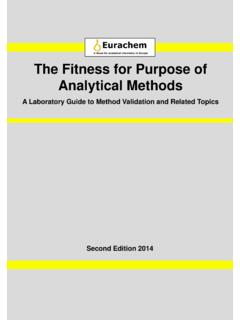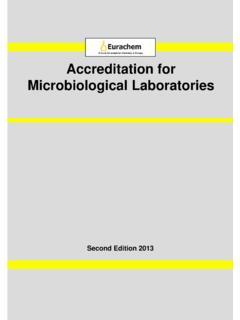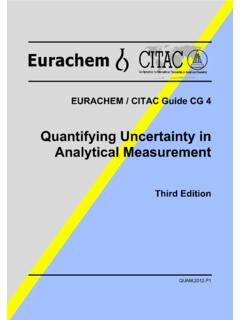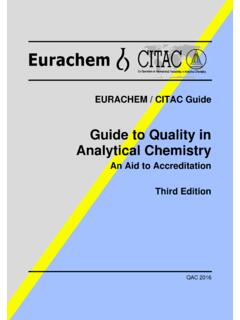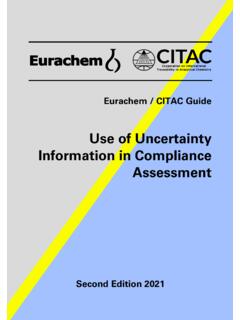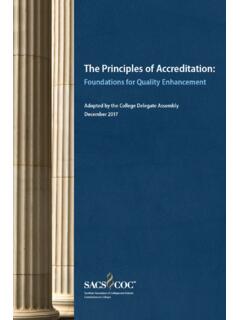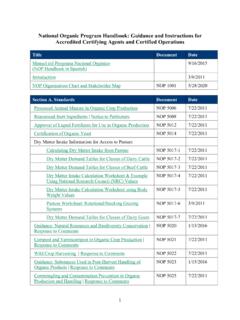Transcription of THE SELECTION AND USE OF REFERENCE MATERIALS A BASIC …
1 EEE/RM/062rev3 THE SELECTION AND USE OF REFERENCE MATERIALS A BASIC guide FOR laboratories AND accreditation bodies ABSTRACT The aim of this paper is to provide a short, simple and user-friendly guide for laboratories , and accreditation and certification bodies . It employs mainly ISO (3) and VIM (1) definitions and provides references to other more comprehensive and expert texts. It is intended to provide help for the inexperienced rather than the expert and necessarily simplifies some topics. It includes discussion and clarification of some misunderstood issues. Although based on the requirements of chemical measurement, it is intended to be also of use in other areas of measurement. INTRODUCTION There are a number of authoritative and detailed texts on various aspects of REFERENCE MATERIALS and these are listed at the end of this paper, together with some internationally recognised (1-4) definitions.
2 This paper aims to provide a simple guide on the use of REFERENCE MATERIALS (RMs) within a wider quality programme. REFERENCE MATERIALS are an important tool in realising a number of aspects of measurement quality and are used for method validation, calibration, estimation of measurement uncertainty, training and for internal quality control (QC) and external quality assurance (QA) (proficiency testing) purposes. In the wider sense, the validity of measurements can be assured when: work is carried out to a clearly defined customer requirement validated methods and equipment are used qualified and competent staff undertake the work comparability with measurements made in other laboratories is assured (traceability and measurement uncertainty) independent evidence of performance is available (proficiency testing) well defined QC and QA procedures are employed, preferably involving third party accreditation Often a measurement operation serves more than one quality purpose and there can be overlap of function as illustrated in Figure 1.
3 Different types of REFERENCE MATERIALS are required for different functions. For example, a certified REFERENCE material would be desirable for method validation but a working level REFERENCE material would be adequate for QC. More detailed guidance on the QA of chemical measurements, including cover of REFERENCE MATERIALS , calibration, QC and validation is provided in a joint CITAC Eurachem guide (5). TYPES OF REFERENCE MATERIALS RMs are used to support measurements concerned with chemical composition, biological, clinical, physical, engineering properties and miscellaneous areas such as taste and odour. They may be characterised for identity ( chemical structure, fibre type, microbiological species etc.) or for property values ( amount of specified chemical entity, hardness etc.). Some commonly encountered types of REFERENCE MATERIALS are as follows: 1.
4 Pure substances characterised for chemical purity and/or trace impurities. 2. Standard solutions and gas mixtures, often prepared gravimetrically from pure substances and used for calibration purposes. 3. Matrix REFERENCE MATERIALS , characterised for the composition of specified major, minor or trace chemical constituents. Such MATERIALS may be prepared from matrices containing the components of interest, or by preparing synthetic mixtures. Page 2 of 10 4. Physico-chemical REFERENCE MATERIALS characterised for properties such as melting point, viscosity, and optical density. 5. REFERENCE objects or artefacts characterised for functional properties such as taste, odour, octane number, flash point and hardness. This type also includes microscopy specimens characterised for properties ranging from fibre type to microbiological specimens.
5 CLASSIFICATION OF REFERENCE MATERIALS Two classes of MATERIALS are recognised by ISO, namely certified REFERENCE MATERIALS ' (CRMs) and REFERENCE MATERIALS (RMs). CRMs must by definition be traceable to an accurate realisation of the unit in which the property values are expressed. Each property value must be accompanied by an uncertainty at a stated level of confidence. RMs are MATERIALS whose property values are sufficiently homogeneous and well established to be used for the calibration of an apparatus, the assessment of a measurement method, or for assigning values to MATERIALS . For most chemical REFERENCE MATERIALS produced before the late 1990s, the measurement uncertainty values given by the producers are unlikely to have been estimated by the now recommended ISO (6,7) procedure. The actual uncertainty can be expected to be larger than stated by a factor of 2-3, where only within laboratory precision measurements are used and by a smaller factor where certification included a range of validated methods and a number of laboratories .
6 Also some MATERIALS sold as CRMs have no stated traceability. The following classes of REFERENCE MATERIALS are also encountered: Primary REFERENCE material Secondary REFERENCE MATERIALS Decreasing Uncertainty In-house or working REFERENCE material Other terminology, such as NIST Standard REFERENCE MATERIALS (SRMs) is also used and a classification (class O - V) based on degree of traceability to SI has been proposed (8). Pan (9) has also published a useful paper on this topic. An internationally recognised quality approval system to assure the competence of RM producers (based on ISO guide 34 and REFERENCE 10) is under consideration within the International Laboratory accreditation Co operation, but it will take some years for any system to make a significant impact on the market place. Users must, therefore, be cautious and seek clear evidence of the quality and traceability of the property values of MATERIALS from suppliers as detailed below.
7 TRACEABILITY OF REFERENCE MATERIALS A short review of the concept and practice of traceability in chemical measurement is available in REFERENCE 5. REFERENCE MATERIALS are important tools for the transfer of measurement accuracy between laboratories and their property values should, where feasible, be traceable to SI. Traceability is, however, a relatively new concept in the field of chemical measurement and as a consequence very few chemical REFERENCE MATERIALS are explicitly traceable to SI. A hierarchy of methods is, however, used for assigning property values to MATERIALS and even if not stated, their traceability can be described as follows: Measurement Method Traceability Primary method SI Method of known bias SI/International standard Independent method(s) Results of specified methods Interlaboratory comparison Results of specified methods Page 3 of 10 A combination of certification procedures is sometimes employed, such as a consensus value derived from an interlaboratory comparison where primary methods were used.
8 In the absence of formally stated traceability it will be necessary for the user to make judgements about implicit traceability, based on the certification data available in reports and the technical literature. It is important to ensure that chemical interferences and matrix effects are adequately addressed in arriving at both the certified value and its uncertainty. Unknown levels of bias are not uncommon and contribute to lack of agreement of measurements. The measurement uncertainty of the property value of a REFERENCE material employed in a measurement process, will contribute to the uncertainty of the final measurement but should contribute less than one third of the overall measurement uncertainty. Any underestimation of the uncertainty of the RM property value will, of course, be carried through to measurements where the RM is used.
9 THE AVAILABILITY AND SELECTION OF REFERENCE MATERIALS Generally the demand for REFERENCE MATERIALS exceeds supply in terms of the range of MATERIALS and availability. It is rare to have a choice of alternative RMs and the user must choose the most suitable material available. It is important therefore that users and accreditation bodies understand any limitations of REFERENCE MATERIALS employed. There are, however, several hundred organisations producing tens of thousands of REFERENCE MATERIALS worldwide. Producers include internationally renowned institutions such as NIST; collaborative government sponsored programs such as the EU BCR program, semi-commercial sectoral or trade associations such as the American Oil Chemicals Association and an increasing number of commercial organisations. The distinction between government institutes and commercial businesses is disappearing with the privatisation of a number of national laboratories .
10 Not all MATERIALS that are used as REFERENCE MATERIALS are described as such. Commercially available chemicals of varying purity, commercial matrix MATERIALS and products from research programs are often used as standards or REFERENCE MATERIALS . In the absence of certification data provided by the supplier it is the responsibility of the user to assess the information available and undertake further characterisation as appropriate. Guidance on the preparation of REFERENCE MATERIALS is given in ISO Guides 31, 34 and 35 and guides on the preparation of working level REFERENCE MATERIALS are also available (12,13). Information about REFERENCE MATERIALS is available from a number of sources. The COMAR Database, contains information on more than 10,000 RMs/CRMs which can be accessed directly or through institutes which provide an advisory service.
